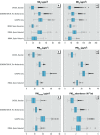Air Pollution Exposure during Pregnancy and Childhood Autistic Traits in Four European Population-Based Cohort Studies: The ESCAPE Project
- PMID: 26068947
- PMCID: PMC4710593
- DOI: 10.1289/ehp.1408483
Air Pollution Exposure during Pregnancy and Childhood Autistic Traits in Four European Population-Based Cohort Studies: The ESCAPE Project
Abstract
Background: Prenatal exposure to air pollutants has been suggested as a possible etiologic factor for the occurrence of autism spectrum disorder.
Objectives: We aimed to assess whether prenatal air pollution exposure is associated with childhood autistic traits in the general population.
Methods: Ours was a collaborative study of four European population-based birth/child cohorts-CATSS (Sweden), Generation R (the Netherlands), GASPII (Italy), and INMA (Spain). Nitrogen oxides (NO2, NOx) and particulate matter (PM) with diameters of ≤ 2.5 μm (PM2.5), ≤ 10 μm (PM10), and between 2.5 and 10 μm (PM(coarse)), and PM2.5 absorbance were estimated for birth addresses by land-use regression models based on monitoring campaigns performed between 2008 and 2011. Levels were extrapolated back in time to exact pregnancy periods. We quantitatively assessed autistic traits when the child was between 4 and 10 years of age. Children were classified with autistic traits within the borderline/clinical range and within the clinical range using validated cut-offs. Adjusted cohort-specific effect estimates were combined using random-effects meta-analysis.
Results: A total of 8,079 children were included. Prenatal air pollution exposure was not associated with autistic traits within the borderline/clinical range (odds ratio = 0.94; 95% CI: 0.81, 1.10 per each 10-μg/m3 increase in NO2 pregnancy levels). Similar results were observed in the different cohorts, for the other pollutants, and in assessments of children with autistic traits within the clinical range or children with autistic traits as a quantitative score.
Conclusions: Prenatal exposure to NO2 and PM was not associated with autistic traits in children from 4 to 10 years of age in four European population-based birth/child cohort studies.
Citation: Guxens M, Ghassabian A, Gong T, Garcia-Esteban R, Porta D, Giorgis-Allemand L, Almqvist C, Aranbarri A, Beelen R, Badaloni C, Cesaroni G, de Nazelle A, Estarlich M, Forastiere F, Forns J, Gehring U, Ibarluzea J, Jaddoe VW, Korek M, Lichtenstein P, Nieuwenhuijsen MJ, Rebagliato M, Slama R, Tiemeier H, Verhulst FC, Volk HE, Pershagen G, Brunekreef B, Sunyer J. 2016. Air pollution exposure during pregnancy and childhood autistic traits in four European population-based cohort studies: the ESCAPE Project. Environ Health Perspect 124:133-140; http://dx.doi.org/10.1289/ehp.1408483.
Conflict of interest statement
F.C.V. is a remunerated contributing editor of the Achenbach System of Empirically Based Assessment. The other authors declare they have no actual or potential competing financial interests.
Figures


Comment in
-
Weeding Out Risk Factors? Study Reports No Association between Prenatal Air Pollution and Autism.Environ Health Perspect. 2016 Jan;124(1):A23. doi: 10.1289/ehp.124-A23. Environ Health Perspect. 2016. PMID: 26720835 Free PMC article. No abstract available.
References
-
- Achenbach TM, Rescorla LA. Burlington, VT: University of Vermont, Research Center for Children, Youth, & Families; 2000. Manual for the ASEBA Preschool Forms & Profiles.
-
- Anckarsäter H, Lundström S, Kollberg L, Kerekes N, Palm C, Carlström E, et al. The Child and Adolescent Twin Study in Sweden (CATSS). Twin Res Hum Genet. 2011;14(6):495–508. - PubMed
-
- Baron-Cohen S, Scott FJ, Allison C, Williams J, Bolton P, Matthews FE, et al. Prevalence of autism-spectrum conditions: UK school-based population study. Br J Psychiatry. 2009;194(6):500–509. - PubMed
-
- Beelen R, Hoek G, Vienneau D, Eeftens M, Dimakopoulou K, Pedeli X, et al. Development of NO2 and NOx land use regression models for estimating air pollution exposure in 36 study areas in Europe – the ESCAPE project. Atmos Environ. 2013;72:10–23.
Publication types
MeSH terms
Substances
LinkOut - more resources
Full Text Sources
Other Literature Sources
Medical

